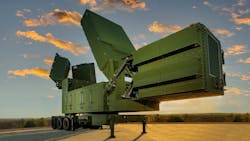Raytheon begins early small-quantity production of LTAMDS gallium nitride (GaN) missile-defense radar system
REDSTONE ARSENAL, Ala. – The U.S. Army is moving RTX Corp. to low-rate initial production of an advanced missile-defense radar system to counter enemy tactical missiles.
Officials of the Army Contracting Command at Redstone, Arsenal, Ala., announced a $2.09 billion contract to the RTX Raytheon segment in Andover, Mass., last week for low-rate initial production of Lower Tier Air and Missile Defense System (LTAMDS).
This system, also known as GhostEye, is the next generation, 360-degree missile-defense radar that ultimately will replace the Army's current Patriot missile radars. The LTAMDS radar has gallium nitride (GaN) components. Low rate initial production (LRIP) describes early small-quantity production.
LTAMDS consists of a primary antenna array on the front of the radar, and two secondary arrays on the rear. The radar antennas work together to enable operators to detect and engage several threats simultaneously from any direction, ensuring there are no blind spots on the battlefield.
The LTAMDS primary array is roughly the same size as the Patriot radar array, but provides more than twice Patriot's performance. While it is designed for the U.S. Army's Integrated Air and Missile Defense system, LTAMDS also will be able to preserve previous Patriot investments.
Raytheon is working with hundreds of suppliers across 42 states, including a core team playing a strategic role in building the LTAMDS solution.
Orolia USA in Rochester, N.Y., for example, is providing the company's rugged SecureSync time and frequency system to supply positioning, navigation, and timing (PNT) capability for LTAMDS.
Crane Aerospace & Electronics in Lynnwood, Wash., is providing defense power systems for power control and conditioning for LTAMDS. Mercury Systems Inc. in Andover, Mass., is providing high-performance digital signal processing and RF solutions for LTAMDS.
On this contract Raytheon will do the work in Andover, Mass., and should be finished by November 2028. For more information contact RTX Raytheon online at https://www.rtx.com/raytheon.
About the Author
John Keller
Editor-in-Chief
John Keller is the Editor-in-Chief, Military & Aerospace Electronics Magazine--provides extensive coverage and analysis of enabling electronics and optoelectronic technologies in military, space and commercial aviation applications. John has been a member of the Military & Aerospace Electronics staff since 1989 and chief editor since 1995.
